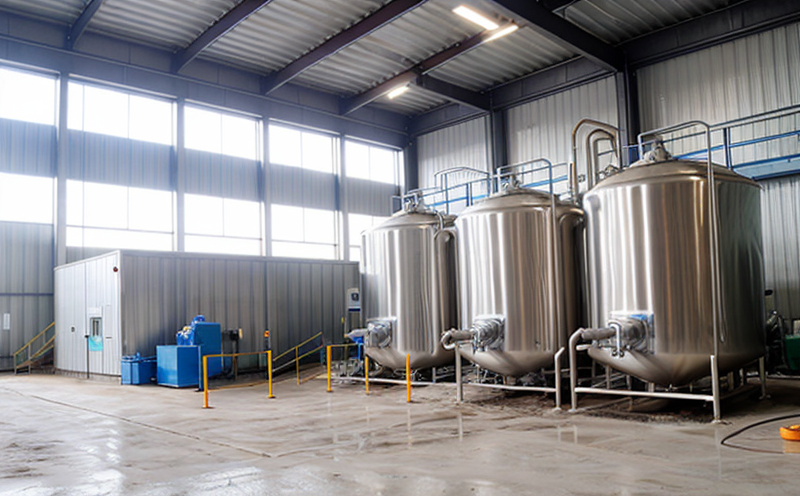ASTM D8026 Surfactants Test in Industrial Water
The ASTM D8026 standard test method is a crucial tool used to assess surfactant levels in industrial water. This method quantifies the concentration of anionic, cationic, and nonionic surfactants in water samples through a combination of extraction with tert-butyl methyl ether (t-BME) followed by spectrophotometric detection.
The significance of this test lies in its ability to ensure that industrial processes operate within safe limits for both the environment and human health. Surfactants, which are widely used in various applications such as detergents, emulsifiers, dispersants, and solubilizers, can have adverse effects if their concentration exceeds recommended levels.
The ASTM D8026 method is particularly important because it provides a standardized approach to measuring surfactant concentrations. This standardization ensures consistency across different laboratories and helps in making accurate decisions regarding the quality of industrial water used in various processes. The test results are essential for compliance with environmental regulations, product specifications, and internal process control.
The extraction step involves immersing the sample in t-BME under controlled conditions to extract surfactants into a liquid phase. This solvent is chosen due to its high solubility of many surfactants without interfering with their optical properties during spectrophotometric measurement. After extraction, the samples are centrifuged and filtered before being analyzed.
The spectrophotometric detection uses a specific wavelength that interacts selectively with the extracted surfactants. This selective interaction allows for precise quantification based on absorbance readings. The method is sensitive enough to detect trace amounts of surfactants, making it suitable for both routine monitoring and troubleshooting unusual conditions in industrial water systems.
The ASTM D8026 test also provides guidance on sample preparation, including proper storage and handling techniques to minimize potential errors. Proper sample preparation is critical as even small deviations can lead to significant discrepancies in results. The standard specifies precise procedures for filtering, diluting, and storing samples before analysis.
Understanding the implications of surfactant levels in industrial water involves recognizing their role in various processes. For example, high concentrations may interfere with membrane operations or reduce the efficiency of cleaning systems. Conversely, insufficient levels could lead to ineffective product formulations or incomplete waste treatment.
The ASTM D8026 method is not only important for ensuring compliance but also supports continuous improvement by providing actionable data. By regularly monitoring surfactant levels, industrial facilities can identify trends and address issues early on. This proactive approach helps prevent costly downtime and ensures sustainable operations.
Why It Matters
The importance of the ASTM D8026 test cannot be overstated in safeguarding both environmental integrity and product quality. Properly conducted, this test ensures that industrial processes adhere to stringent standards set by regulatory bodies like the Environmental Protection Agency (EPA) and industry associations.
- Environmental Impact: Excessive surfactants can degrade aquatic ecosystems by altering pH levels, reducing oxygen availability, and disrupting natural biological balances. By adhering to ASTM D8026 standards, industries contribute positively towards preserving water quality.
- Product Quality: Consistent surfactant concentrations are vital for maintaining uniform performance across batches of products. Non-compliance can result in variations that impact customer satisfaction and brand reputation negatively.
The test results derived from ASTM D8026 serve as a critical benchmark against which all industrial water supplies must be evaluated regularly. Regular compliance checks help maintain consistency, thereby enhancing overall process reliability and efficiency.
Furthermore, the standard contributes to safer working environments by ensuring that employees are not exposed unnecessarily to potentially harmful substances during their day-to-day activities. This precautionary measure aligns with broader occupational health and safety initiatives aimed at protecting workers' well-being.
Industry Applications
- Agricultural Industry: Monitoring surfactant levels helps optimize irrigation systems, ensuring efficient water usage without compromising crop yields.
- Mining Sector: This test plays a key role in managing wastewater from mining operations, preventing contamination of nearby watersheds and aquatic habitats.
- Petrochemical Industry: Ensuring proper surfactant concentration is essential for effective oil recovery processes while minimizing ecological damage.
- Pharmaceutical Manufacturing: The consistent quality control provided by ASTM D8026 ensures that pharmaceutical products meet stringent purity and efficacy standards.
In addition to these sectors, many others rely on the accuracy of surfactant measurements for their operations. For instance, pulp and paper mills use this method to monitor effluent discharge from their processes, while food processing plants apply it to maintain hygiene standards throughout production lines.
The versatility of ASTM D8026 extends beyond just measuring surfactants; its application spans across numerous industries where water quality plays a pivotal role in meeting regulatory requirements and operational goals. By leveraging this standardized approach, companies can enhance their sustainability efforts while simultaneously improving product quality and worker safety.
Customer Impact and Satisfaction
- Enhanced Compliance: Customers who utilize ASTM D8026-compliant services benefit from reduced risk of non-compliance penalties, thereby protecting their reputation and financial stability.
- Improved Process Efficiency: Accurate surfactant measurement leads to optimized industrial processes, resulting in higher productivity rates and lower operational costs.
- Better Product Quality: Consistent surfactant levels contribute significantly to producing high-quality products that meet or exceed customer expectations.
- Increased Safety: By ensuring safe working conditions through accurate monitoring, customers can enhance employee morale and retention rates.
The positive impacts extend beyond immediate stakeholders; satisfied clients often translate into repeat business opportunities and favorable word-of-mouth recommendations. This sustained relationship fosters long-term partnerships built on trust and reliability—key factors in establishing a strong market presence for any company operating within the industrial sector.
Moreover, adherence to ASTM D8026 helps build confidence among stakeholders regarding the quality of services offered. This transparency encourages greater engagement from end-users who appreciate knowing they are receiving reliable information backed by recognized international standards.





